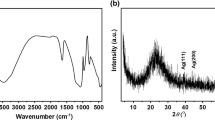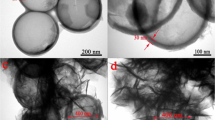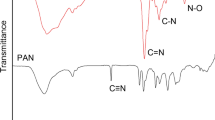Abstract
Biofouling caused by marine microorganisms could remarkably decrease the adsorption capacity of adsorbents towards uranium extraction from seawater since the materials usually have to be immersed in marine environment for several months owing to the extremely low content of uranium. In order to avoid the interference of microbial adhesion, this work designed and fabricated a new antibacterial material named amidoximated silver-silica core–shell nanoparticle (Ag@SiO2-AO) as a potential adsorbent for uranium extraction from seawater. Experimental results demonstrated that in uranium-spiked seawater, the maximal uranium uptake of Ag@SiO2-AO reached 47.42 mg/g, and the silver released by the material was effective to inhibit Escherichia coli and Staphylococcus aureus by interrupting cell respiration, resulting in lipid peroxidation and ultimately the death of cell.














Similar content being viewed by others
References
NEW/IAEA (2021) Uranium 2020: resources, production and demand. Éditions OCDE, Paris. https://doi.org/10.1787/d82388ab-en
Li JQ et al (2017) Direct extraction of U(VI) from alkaline solution and seawater via anion exchange by metal-organic framework. Chem Eng J 316:154–159
Zhao S et al (2019) A dual-surface amidoximated halloysite nanotube for high-efficiency economical uranium extraction from seawater. Angew Chem Int Ed Engl 58(42):14979–14985
Kumari N et al (2011) Extraction studies of uranium into a third-phase of thorium nitrate employing tributyl phosphate and N,N-dihexyl octanamide as extractants in different diluents. J Radioanal Nucl Chem 289(3):835–843
Yuan Y et al (2019) Ultrafast recovery of uranium from seawater by Bacillus velezensis strain UUS-1 with innate anti-biofouling activity. Adv Sci (Weinh) 6(18):1900961
Yuan F et al (2017) Synthesis of phytic acid-decorated titanate nanotubes for high efficient and high selective removal of U(VI). Chem Eng J 322:353–365
Guo X et al (2015) Sequestering uranium from UO2(CO3)3(4-) in seawater with amine ligands: density functional theory calculations. Phys Chem Chem Phys 17(22):14662–14673
Wang CZ et al (2014) Theoretical insights on the interaction of uranium with amidoxime and carboxyl groups. Inorg Chem 53(18):9466–9476
Parker BF et al (2018) An overview and recent progress in the chemistry of uranium extraction from seawater. Dalton Trans 47(3):639–644
Abney CW et al (2017) Materials for the recovery of uranium from seawater. Chem Rev 117(23):13935–14013
Uzun D et al (2021) A CFD study: Influence of biofouling on a full-scale submarine. Appl Ocean Res 109(1):102561
Yebra DM et al (2004) Antifouling technology—past, present and future steps towards efficient and environmentally friendly antifouling coatings. Prog Org Coat 50(2):75–104
Park J et al (2016) Effect of biofouling on the performance of amidoxime-based polymeric uranium adsorbents. Ind Eng Chem Res 55(15):4328–4338
Gill GA et al (2016) The uranium from seawater program at the Pacific Northwest National Laboratory: overview of marine testing, adsorbent characterization, adsorbent durability, adsorbent toxicity, and deployment studies. Ind Eng Chem Res 55(15):4264–4277
Guo X et al (2018) Superhydrophilic phosphate and amide functionalized magnetic adsorbent: a new combination of anti-biofouling and uranium extraction from seawater. Environ Sci Nano 5(10):2346–2356
Zhang H et al (2018) Guanidine and amidoxime cofunctionalized polypropylene nonwoven fabric for potential uranium seawater extraction with antifouling property. Ind Eng Chem Res 57(5):1662–1670
Yu Q et al (2019) A universally applicable strategy for construction of anti-biofouling adsorbents for enhanced uranium recovery from seawater. Adv Sci (Weinh) 6(13):1900002
Wen J et al (2018) Nano-TiO2 imparts amidoximated wool fibers with good antibacterial activity and adsorption capacity for uranium(VI) recovery. Ind Eng Chem Res 57(6):1826–1833
Oves M et al (2018) Antimicrobial and anticancer activities of silver nanoparticles synthesized from the root hair extract of Phoenix dactylifera. Mater Sci Eng C Mater Biol Appl 89:429–443
Yin IX et al (2020) The antibacterial mechanism of silver nanoparticles and its application in dentistry. Int J Nanomed 15:2555–2562
Huang F et al (2017) Silver-decorated polymeric micelles combined with Curcumin for enhanced antibacterial activity. ACS Appl Mater Interfaces 9(20):16880–16889
Fahmy HM et al (2019) Coated silver nanoparticles: synthesis, cytotoxicity, and optical properties. RSC Adv 9(35):20118–20136
Ballottin D et al (2017) Antimicrobial textiles: Biogenic silver nanoparticles against Candida and Xanthomonas. Mater Sci Eng C Mater Biol Appl 75:582–589
Lv Y et al (2009) Silver nanoparticle-decorated porous ceramic composite for water treatment. J Membr Sci 331(1–2):50–56
Zhang Q et al (2021) Catalytical and antibacterial sugarcane filter decorated with sliver nanoparticle for water treatment. Ind Crops Prod 164
Somasundaran P et al (2016) A novel processing scheme for core—shell nano composites using controlled polymer adsorption. Mater Res Innov 2(6):325-327
Kang H et al (2019) Stabilization of silver and gold nanoparticles: preservation and improvement of plasmonic functionalities. Chem Rev 119(1):664–699
Venkatesham M et al (2012) A novel green one-step synthesis of silver nanoparticles using chitosan: catalytic activity and antimicrobial studies. Appl Nanosci 4(1):113–119
Abdul Kareem T et al (2011) Synthesis and thermal study of octahedral silver nano-plates in polyvinyl alcohol (PVA). Arab J Chem 4(3):325–331
Gawande MB et al (2015) Core-shell nanoparticles: synthesis and applications in catalysis and electrocatalysis. Chem Soc Rev 44(21):7540–7590
Mondal K et al (2016) Recent advances in the synthesis and application of photocatalytic metal–metal oxide core–shell nanoparticles for environmental remediation and their recycling process. RSC Adv 6(87):83589–83612
Chen Q et al (2018) Nanostructures confined self-assembled in biomimetic nanochannels for enhancing the sensitivity of biological molecules response. J Mater Sci: Mater Electron 29(23):19757–19767
Kim C et al (2018) Surface-optimized core–shell nanocomposites (Fe3O4@MnxFeyO4) for ultra-high uranium sorption and low-field separation in water. Environ Sci Nano 5(10):2252–2256
Tan L et al (2015) Preparation of magnetic core-shell iron oxide@silica@nickel-ethylene glycol microspheres for highly efficient sorption of uranium(VI). Dalton Trans 44(15):6909–6917
Carlson C et al (2008) Unique cellular interaction of silver nanoparticles: size-dependent generation of reactive oxygen species. J Phys Chem B 112(43):13608–13619
Zhang XS et al (2011) Monodisperse Ag@SiO2 core-shell nanoparticles as active inhibitors for marine anticorrosion applications. J Nanosci Nanotechnol 11(4):3481–3487
Lu X et al (2011) A preliminary study of the microbial resources and their biological activities of the East China Sea. Evid Based Complement Alternat Med 2011:806485
Shan D et al (2015) Distribution and diversity of bacterioplankton communities in subtropical seawater around Xiamen Island, China. Microbiol Res 175:16–23
Yu SX et al (2018) Distribution of bacterial communities along the spatial and environmental gradients from Bohai Sea to northern Yellow Sea. PeerJ 6:e4272
Feng BW et al (2009) Bacterial diversity of water and sediment in the Changjiang estuary and coastal area of the East China Sea. FEMS Microbiol Ecol 70(2):80–92
Zhang Y et al (2018) Community differentiation of bacterioplankton in the epipelagic layer in the South China Sea. Ecol Evol 8(10):4932–4948
Sun FL et al (2015) Spatial and vertical distribution of bacterial community in the northern South China Sea. Ecotoxicology 24(7–8):1478–1485
Zhang Y et al (2007) Dynamics of aerobic anoxygenic phototrophic bacteria in the East China Sea. FEMS Microbiol Ecol 61(3):459–469
He Y et al (2017) Distinct seasonal patterns of bacterioplankton abundance and dominance of phyla alpha-proteobacteria and cyanobacteria in qinhuangdao coastal waters off the Bohai Sea. Front Microbiol 8:1579
Zhang L et al (2015) Extended X-ray absorption fine structure and density functional theory studies on the complexation mechanism of amidoximate ligand to uranyl carbonate. Ind Eng Chem Res 55(15):4224–4230
Lv Z et al (2019) Enhanced removal of uranium(VI) from aqueous solution by a novel Mg-MOF-74-derived porous MgO/carbon adsorbent. J Colloid Interface Sci 537:A1–A10
Maher K et al (2013) Environmental speciation of actinides. Inorg Chem 52(7):3510–3532
Marques Fernandes M et al (2012) U(VI) sorption on montmorillonite in the absence and presence of carbonate: a macroscopic and microscopic study. Geochim Cosmochim Acta 93:262–277
Zhang A et al (2003) The adsorption mechanism of uranium(VI) from seawater on a macroporous fibrous polymeric adsorbent containing amidoxime chelating functional group. React Funct Polym 57(1):67–76
Krestou A et al (2004) Uranium (VI) Speciation Diagrams in the UO22+/CO32-/H2O System at 25°C. Eur J Miner Process Environ Prot 4:113–129
Zhao D et al (2020) An amidoxime-functionalized polypropylene fiber: Competitive removal of Cu(II), Pb(II) and Zn(II) from wastewater and subsequent sequestration in cement mortar. J Clean Prod 274:123049
Wang C-Z et al (2017) Complexation of vanadium with amidoxime and carboxyl groups: uncovering the competitive role of vanadium in uranium extraction from seawater. Radiochim Acta 105(7):541–553
Ochsenkhn-Petropulu M et al (1993) Separation of uranium from uraniferous coaly clays using a selective ion-exchange two-step elution system. Fresenius J Anal Chem 345(1):43–47
Guettaf H et al (2009) Concentration-purification of uranium from an acid leaching solution. Phys Procedia 2(3):765–771
Injarean U et al (2014) Batch simulation of multistage countercurrent extraction of uranium in yellow cake from monazite processing with 5% TBP/kerosene. Energy Procedia 56:129–134
AshaRani PV et al (2009) Cytotoxicity and genotoxicity of silver nanoparticles in human cells. ACS Nano 3(2):279–290
Holt KB et al (2005) Interaction of silver(I) ions with the respiratory chain of Escherichia coli: an electrochemical and scanning electrochemical microscopy study of the antimicrobial mechanism of micromolar Ag+. Biochemistry 44(39):13214–13223
Matés JM et al (2000) Role of reactive oxygen species in apoptosis: implications for cancer therapy. Int J Biochem Cell Biol 32(2):157–170
Xu H et al (2012) Role of reactive oxygen species in the antibacterial mechanism of silver nanoparticles on Escherichia coli O157:H7. Biometals 25(1):45–53
Matsumura Y et al (2003) Mode of bactericidal action of silver zeolite and its comparison with that of silver nitrate. Appl Environ Microbiol 69(7):4278–4281
Singh AV et al (2014) Carbon nanotube-induced loss of multicellular chirality on micropatterned substrate is mediated by oxidative stress. ACS Nano 8(3):2196–2205
Porter NA (2013) A perspective on free radical autoxidation: the physical organic chemistry of polyunsaturated fatty acid and sterol peroxidation. J Org Chem 78(8):3511–3524
Rival T et al (2013) Alteration of plasma phospholipid fatty acid profile in patients with septic shock. Biochimie 95(11):2177–2181
Acknowledgements
This study was supported by the National Natural Science Foundation of China (21876073).
Author information
Authors and Affiliations
Corresponding author
Additional information
Publisher's Note
Springer Nature remains neutral with regard to jurisdictional claims in published maps and institutional affiliations.
Supplementary Information
Below is the link to the electronic supplementary material.
Rights and permissions
Springer Nature or its licensor holds exclusive rights to this article under a publishing agreement with the author(s) or other rightsholder(s); author self-archiving of the accepted manuscript version of this article is solely governed by the terms of such publishing agreement and applicable law.
About this article
Cite this article
Mo, H., Sun, R., Qu, C. et al. Preparation and performance of amidoximated silver-silica core–shell nanoparticles for uranium extraction from seawater. J Radioanal Nucl Chem 331, 4541–4552 (2022). https://doi.org/10.1007/s10967-022-08514-8
Received:
Accepted:
Published:
Issue Date:
DOI: https://doi.org/10.1007/s10967-022-08514-8




